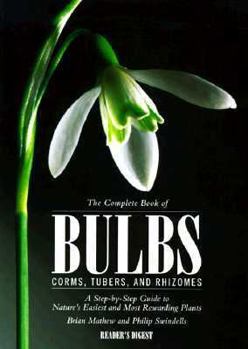Comp Bk of Bulbs
This comprehensive, season-by-season plant directory describes more than 750 recommended species and varieties, offers step-by-step illustrations and expert tips on selection, growth, propagation and... This description may be from another edition of this product.
Format:Paperback
Language:English
ISBN:0895775468
ISBN13:9780895775467
Release Date:January 1994
Publisher:Reader's Digest Association
Length:240 Pages
Weight:2.82 lbs.
Dimensions:1.0" x 8.3" x 11.1"
Customer Reviews
1 rating
Practical but concise guide to underground goodies.
Published by Thriftbooks.com User , 17 years ago
`The Complete Book of Bulbs, Corms, Tubers, and Rhizomes' by Brian Mathew and Philip Swindells, both British horticulturists, is an ambitious title which comes about as close as a 240 page book, even an oversized 240 paged book can come to being anywhere close to a `complete' treatment of such a broad subject. The very first thing I notice about the book are the really attractive colored drawings used to illustrate some of the more important points in the beginning of the book, such as the tables illustrating planting depth. As nice as photographs are for most purposes, a colored drawing is often even better, because it focuses on the one important idea it is trying to communicate, leaving out every extraneous detail, not to mention unwelcome shadows and ill-positioned lighting. The second thing that appeals to me is the heavy use of accurate scientific nomenclature. In the world of flowers where there are often several different names for the same thing, the only sure way you know you are talking about the same thing in two different books is if you use the scientific name. This extends even to common group names, so that in place of daffodils, all talk is of narcissus and in place of amaryllis, we discuss Hippeastrum. And, thankfully, the common but unused terms do appear in the index with a pointer to the term being used to identify the plant type. While the book discusses four different types of underground structures that store nourishment from blooming to blooming, the book is organized more by season than by type of plant. Since most of us are far less concerned about whether our crocus plants are bulbs or corms (they are corms) than we are about when to plant what, this makes a lot of sense. Thus, for each season, there is a list of plants of all four types that bloom in that season. The first 57 pages are taken up with introductory chapters that again focus on function rather than on variety (after a brief introduction covering the difference between the four). The highlight of this introduction is a very nicely drawn `life cycle' for a representative of each of the four plant types. One thing I find just a bit surprising is that while this `complete' book seems to cover all perennials with underground food storage structures, it does not. For example, it says virtually nothing about dahlias, which my unabridged dictionary describes as having tuberous roots and does a very good job of reminding me of that famous tuber, the potato. I will take it on faith that dahlia's are not `true' tubers and are therefore outside the purview of this book (but maybe they should have said something to this effect). The list of suppliers is very nice and as a heavy customer of U.S. purveyors of bulbs, it looks pretty complete to me. A real novelty, interesting, but of no practical use for us Yanks is maps of European, Australian, and New Zealand planting zones. Oi, Oi, Oi! A very nice book if you can come by a copy for less than the $30 list price.




